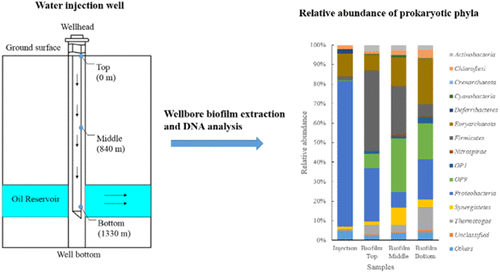当前位置:
X-MOL 学术
›
Energy Fuels
›
论文详情
Our official English website, www.x-mol.net, welcomes your
feedback! (Note: you will need to create a separate account there.)
Community Distribution of Biofilms along a Vertical Wellbore in a Deep Injection Well during Petroleum Production
Energy & Fuels ( IF 5.2 ) Pub Date : 2021-01-22 , DOI: 10.1021/acs.energyfuels.0c02963 Pengrui Zhu 1 , Zhiyong Song 1 , Xiaoling Wu 2 , Peng Xu 2 , Xiaofei Zhang 3 , Weiyao Zhu 1
Energy & Fuels ( IF 5.2 ) Pub Date : 2021-01-22 , DOI: 10.1021/acs.energyfuels.0c02963 Pengrui Zhu 1 , Zhiyong Song 1 , Xiaoling Wu 2 , Peng Xu 2 , Xiaofei Zhang 3 , Weiyao Zhu 1
Affiliation

|
In petroleum production, microbial investigations are essential for microbial-induced corrosion (MIC) control and enhanced oil recovery (EOR) processes. It is suggested that microorganisms can attach to the inner wall of pipes as biofilms, which are more stable and could cause more serious corrosion than planktonic microorganisms in the water phase. At present, research on the biofilms during oil production is mainly focused on the surface pipelines, while few reports have directly investigated biofilms in vertical deep wells. Therefore, in this study, wellbore biofilms were sampled during well workover from several well-tube segments corresponding to different original depths (approximately 0, 840, and 1330 m). The injected water was sampled as well. The results of the 16S rRNA gene library sequencing showed that the biofilms and water-phase communities were distinct (dissimilarity of 0.56–0.64), although they shared 64 OTUs. At the phylum level, the relative abundance of Proteobacteria was 74.65% in the water phase and only 7.86–27.41% in the biofilms. The dominant phylum, Firmicutes, was 6.03–41.21% in the three biofilms, while only 1.16% in the water phase. With increasing depth, the biofilm communities became more diverse (Shannon index of 3.43–4.21), more anaerobic, and more thermophilic possibly due to the depleting oxygen and increasing temperature in samples from the deeper well. For instance, the relative abundance of anaerobes (archaea and strict anaerobic bacteria) in biofilms increased from 18.32 to 40.53%. Thermophilic bacteria (such as Kosmotoga) increased from 6.65 to 15.82%. Among methanogens, hydrogenotrophic genera (such as Methanobacterium and Methanolinea) increased from 3.66 to 9.68%. This study revealed the structural differences between water-phase and biofilm communities in the well, and the depth-dependent distribution of the biofilm communities. These results improved the understanding of microbial ecology in wellbores, which will benefit microbial activity control measures applied in oil production processes, including MIC and oil recovery.
中文翻译:

石油生产过程中深注入井中垂直井眼生物膜的群落分布
在石油生产中,微生物研究对于微生物诱导的腐蚀(MIC)控制和提高采油率(EOR)过程至关重要。有人认为,微生物可以以生物膜的形式附着在管道的内壁上,与水相中的浮游微生物相比,它更稳定并且可以引起更严重的腐蚀。目前,对石油生产过程中生物膜的研究主要集中在地表管道上,很少有报道直接研究垂直深井中的生物膜。因此,在这项研究中,在修井期间从对应于不同原始深度(约0、840和1330 m)的几个井管段中取样了井眼生物膜。注入的水也被采样。16S rRNA基因文库测序的结果表明,尽管它们共享64个OTU,但生物膜和水相群落是不同的(相异度为0.56-0.64)。在门级,相对丰度细菌在水相中占74.65%,在生物膜中仅占7.86–27.41%。在这三个生物膜中,主要的门纲Firmicutes为6.03–41.21%,而在水相中仅为1.16%。随着深度的增加,生物膜群落变得更加多样化(香农指数(Shannon index)3.43–4.21),厌氧性和嗜热性更多,这可能是由于更深井中样品的氧气消耗和温度升高所致。例如,生物膜中厌氧菌(古细菌和严格的厌氧菌)的相对丰度从18.32%增加到40.53%。嗜热细菌(例如Kosmotoga)从6.65%增加到15.82%。在产甲烷菌中,氢营养属(如甲烷杆菌和甲醇))从3.66增加到9.68%。这项研究揭示了井中水相和生物膜群落之间的结构差异,以及生物膜群落的深度依赖性分布。这些结果使人们对井眼中的微生物生态学有了更好的了解,这将有益于石油生产过程(包括MIC和采油)中采用的微生物活性控制措施。
更新日期:2021-02-04
中文翻译:

石油生产过程中深注入井中垂直井眼生物膜的群落分布
在石油生产中,微生物研究对于微生物诱导的腐蚀(MIC)控制和提高采油率(EOR)过程至关重要。有人认为,微生物可以以生物膜的形式附着在管道的内壁上,与水相中的浮游微生物相比,它更稳定并且可以引起更严重的腐蚀。目前,对石油生产过程中生物膜的研究主要集中在地表管道上,很少有报道直接研究垂直深井中的生物膜。因此,在这项研究中,在修井期间从对应于不同原始深度(约0、840和1330 m)的几个井管段中取样了井眼生物膜。注入的水也被采样。16S rRNA基因文库测序的结果表明,尽管它们共享64个OTU,但生物膜和水相群落是不同的(相异度为0.56-0.64)。在门级,相对丰度细菌在水相中占74.65%,在生物膜中仅占7.86–27.41%。在这三个生物膜中,主要的门纲Firmicutes为6.03–41.21%,而在水相中仅为1.16%。随着深度的增加,生物膜群落变得更加多样化(香农指数(Shannon index)3.43–4.21),厌氧性和嗜热性更多,这可能是由于更深井中样品的氧气消耗和温度升高所致。例如,生物膜中厌氧菌(古细菌和严格的厌氧菌)的相对丰度从18.32%增加到40.53%。嗜热细菌(例如Kosmotoga)从6.65%增加到15.82%。在产甲烷菌中,氢营养属(如甲烷杆菌和甲醇))从3.66增加到9.68%。这项研究揭示了井中水相和生物膜群落之间的结构差异,以及生物膜群落的深度依赖性分布。这些结果使人们对井眼中的微生物生态学有了更好的了解,这将有益于石油生产过程(包括MIC和采油)中采用的微生物活性控制措施。











































 京公网安备 11010802027423号
京公网安备 11010802027423号